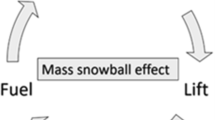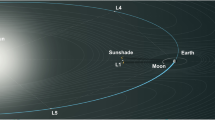Abstract
Insect-sized flapping wing micro air vehicles (MAVs) are beginning to take flight but have many technical hurdles to overcome. One of the greatest challenges of MAV design is attaining lightweight microelectronic components of optimal size and shape. In this paper an inductor for incorporation onto a carbon fiber MAV body component is modeled using a multiphysics and lumped parameter approach. A magnetostatic simulation using finite elements provides insight into the magnetic flux density distribution of the inductor. Simulation allows the inductor to be adapted to various shapes and sizes. Lumped values are generated based upon desired values for a MAV inductor. Microelectromechanical systems (MEMS) processes are used to fabricate the inductor directly on a MAV carbon fiber body (e.g. fuselage) component. Fabrication is prototyped on a semiconductor wafer. The inductor (a major contributor to the MAV weight budget) forms the basis for a lightweight, voltage transformer. By transferring the copper conductors to a structural component, the circuitry becomes part of the vehicle structure. This type of MEMS fabrication allows for optimal sizing, weight reduction, a lower part count and much higher levels of integration. These parameters are critical for operational MAV applications.







Similar content being viewed by others
Abbreviations
- davg :
-
Average spiral diameter, μm
- c1–4 :
-
Inductor constants
- Cox :
-
Spiral substrate oxide capacitance, pF
- Cs :
-
Spiral connector trace capacitance, pF
- I:
-
Current, A
- l :
-
Length of spiral trace, mm
- L s :
-
Inductance of the spiral inductor, μH
- n:
-
Number of spiral turns
- Rs :
-
Spiral series resistance, Ω
- Rsi :
-
Substrate resistance, Ω
- tox :
-
Thickness of the trace oxide, μm
- toxUnd :
-
Thickness of the connector oxide, μm
- w:
-
Trace width, μm
- εox :
-
Oxide permittivity, F/m
- μ:
-
Permeability of the trace, H.m
- ρ:
-
Fill ratio
- σ:
-
Conductivity of the trace, Ω.m
- ω:
-
Angular frequency, rad/s
References
Ahn KK, Truong DQ, Nam DNC, Yoon JI, Yokota S (2010) Position control of ionic polymer metal composite actuator using quantitative feedback theory. Sensor Actuat A-Phys 159:204–212
Galle P, Wu X, Milner L, Kim SH, Johnson P, Smeys P et al (2007) Ultra-compact power conversion based on a CMOS-compatible microfabricated power inductor with minimized core losses. In: 2007 Proceedings of the 57th electronic components technology conference no. 1889–1894. doi:10.1109/ECTC.2007.374056
Gu L, Li X (2007) High-Q solenoid inductors with a CMOS-compatible concave-suspending MEMS process. J Microelectromech Syst 16:1162–1172
Hollar S, Flynn A, Bellew C, Pister KSJ (2003) Solar powered 10 mg silicon robot. In: IEEE sixth annual international conference of micro electro mechanical systems, pp 706–711. doi:10.1109/MEMSYS.2003.1189847
Johnson RA, Chang CE, Asbeck PM, Wood ME, Garcia GA, Lagnado I (1996) Comparison of microwave inductors fabricated on silicon-on-sapphire and bulk silicon. IEEE Microw Guided Wave Lett 6:323–325. doi:10.1109/75.535833
Karásek M, Nan Y, Romanescu I, Preumont A (2013) Pitch moment generation and measurement in arobotic hummingbird. In J Micro Air Vehicles 5:299–310
Karpelson M, Whitney J (2011) Design and fabrication of ultralight high-voltage power circuits for flapping-wing robotic insects. In: Twenty-sixth annual IEEE applied power electronics conference and exposition no. 2070– 2077
Karpelson M, Wei GY, Wood RJ (2008) A review of actuation and power electronics options for flapping-wing robotic insects. In: 2008 IEEE international conference on robotics and automation no. 779–786
Karpelson M, Wei GY, Wood RJ (2009) Milligram-scale high-voltage power electronics for piezoelectric microrobots. In: 2009 IEEE international conference on robotics and automation, no. 2217–2224
Kuhn WB, Mojarradi M (2004) Modeling spiral inductors in SOS processes. IEEE Trans Electron Dev 51:677–683. doi:10.1109/TED.2004.826868
Michelson R, Naqvi M (2003a) Extraterrestrial flight, Von Karman Institute for Fluid Dynamics, RTO/AVT Lect., 1–17
Mohan S (1999) Modeling, design, and optimization of on-chip inductors and transformers, Ph.D. oral examination, Electrical Engineering Dept., Stanford Univ., Stanford, CA
Michelson RC, Naqvi MA (2003b) Beyond biologically inspired insect flight. Von Karman Institute of Fluid Dynamics, 1–19
Nguyen N, Meyer R (1990) Si IC-compatible inductors and LC passive filters. IEEE J Solid-State Circ 25:1028–1031
PiezoDrive (2015) PDu100 micro piezo driver datasheet. Newcastle Innovation Ltd., Callaghan
Reissman T, Park J, Garcia E. (2012) Multilayer, stacked spiral copper inductors on silicon with micro-henry inductance using single-level lithography. In: Active and passive electronic components, 8
Saidani M, Meyer A, Gijs MAM (2003) Hybrid MEMS inductor for miniaturized autonomous power converter. In: IEEE sixth annual international conference on micro electro mechanical systems, no. 586–589
Shahinpoor M, Bar-Cohen Y, Simpson JO, Smith J (1999) Ionic polymer-metal composites (IPMCs) as biomimetic sensors, actuators and artificial muscles-a review. VTT Symp 7:R15
Steltz E, Seeman M, Avadhanula S, Fearing RS (2006) Power electronics design choice for piezoelectric microrobots. In: International conference on intelligent robots and systems, 1322–1328. doi:10.1109/IROS.2006.281897
T.T. University (2011) Microrobotic dragonfly. In: University Alliance Design Competition, 1–28
Karpelson M, Whitney JP, Wei GY, Wood RJ (2010) Energetics of flapping-wing robotic insects: towards autonomous hovering flight. In: IEEE/RSJ international conference on intelligent robots and systems, no. 1630–1637
Wu H, Cangellaris AC (2004) Model-order reduction of finite-element approximations of passive electromagnetic devices including lumped electrical-circuit models. IEEE Trans Microw Theory 52:2305–2313. doi:10.1109/TMTT.2004.834582
Yue CP, Ryu C, Lau J, Lee TH, Wong SS (1996) A physical model for planar spiral inductors on silicon. In: International electron devices meeting, 155–158. doi:10.1109/IEDM.1996.553144
Zdunich P, Bilyk D, MacMaster M, Loewen D, DeLaurier J, Kornbluh R et al (2012) Development and testing of the mentor flapping-wing micro air vehicle. J Aircraft 44:1701–1711
Acknowledgments
This research was done under the auspices of the Centre for Transportation Research at the Faculty of Engineering, University of Malaya. It is primarily funded by High Impact Research Grant UM.C/625/1/HIR/MOHE/ENG/53 (H-16001-D000053), along with a secondary University of Malaya grant: RG155-12AET. The authors are grateful to the Departments of Electrical and Mechanical Engineering, Faculty of Engineering, University of Malaya and Institute of Nano Electronic Engineering (INEE), Universiti Malaysia Perlis (UNIMAP) for providing experimental support with tools and machinery. Special thanks to Professor Dr. Uda Hashim for his guidance and support.
Author information
Authors and Affiliations
Corresponding author
Rights and permissions
About this article
Cite this article
Fearday, C., Ward, T.A., Soin, N. et al. Development of an inductor incorporated onto a carbon fiber MAV structural component. Microsyst Technol 23, 1433–1442 (2017). https://doi.org/10.1007/s00542-016-2958-4
Received:
Accepted:
Published:
Issue Date:
DOI: https://doi.org/10.1007/s00542-016-2958-4




